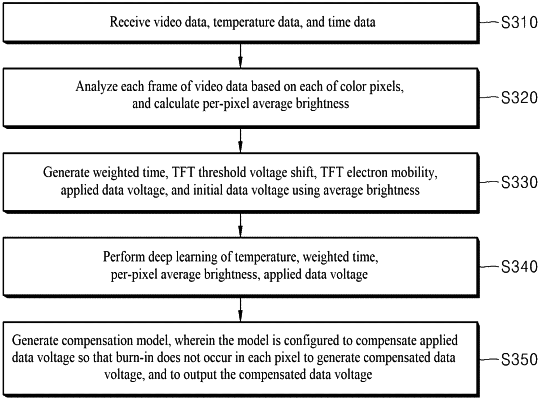| CPC G09G 3/3291 (2013.01) [G06N 3/08 (2013.01); G09G 3/3266 (2013.01); G09G 2310/0289 (2013.01); G09G 2310/08 (2013.01); G09G 2320/046 (2013.01); G09G 2360/16 (2013.01)] | 15 Claims |

|
1. A display device comprising:
a display panel including a plurality of gate lines and a plurality of data lines that intersect each other, and a plurality of pixels, each pixel from the plurality of pixels defined at an intersection of a gate line from the plurality of gate lines and a data line from the plurality of data lines;
a gate driver configured to apply a scan signal to the plurality of gate lines;
a data driver configured to apply a data signal to the plurality of data lines; and
a timing controller configured to control the gate driver and the data driver,
wherein the timing controller includes a micro-chip having a compensation model mounted therein, wherein the compensation model is generated by learning a temperature, a weighted time, an average brightness, an applied data signal, and an initial data signal related to each pixel from the plurality of pixels by a deep learning scheme,
wherein the micro-chip is configured to input the data signal to the compensation model to generate a compensated data signal,
wherein the timing controller is configured to apply the generated compensated data signal to the data driver.
|
|
10. A method for compensating a data signal in a display device that includes: a display panel in which a plurality of gate lines and a plurality of data lines intersect each other, a plurality of pixels where each pixel is defined at an intersection of a gate line from the plurality of gate lines and a data line from the plurality of data lines; a gate driver configured to apply a scan signal to the plurality of gate lines; a data driver configured to apply a data signal to the plurality of data lines; and a timing controller including a micro-chip having a compensation model mounted therein, wherein the compensation model is generated by learning a temperature, a weighted time, an average brightness, an applied data signal, and an initial data signal related to the each pixel from the plurality of pixels in a deep learning scheme, the method comprising:
transmitting, by the timing controller, the data signal to the micro-chip;
inputting, by the micro-chip, the data signal to the compensation model to generate a compensated data signal; and
applying, by the timing controller, the generated compensated data signal to the data driver.
|
|
11. A method for generating a compensation model for a display device in a deep-learning manner, the method comprising:
receiving, by a computer simulator, video data, a temperature,. and time data;
analyzing, by the computer simulator, each frame of the video data based on each of a plurality of color pixels, and calculating, by the computer simulator, a per-pixel average brightness;
generating, by the computer simulator, data including a weighted time, a threshold voltage shift of a thin-film transistor (TFT), an electron mobility, an applied data voltage, and an initial data voltage related to each color pixel from the plurality of color pixels, using the per-pixel average brightness;
learning, by the computer simulator, the weighted time, the per-pixel average brightness, the temperature, and the applied data voltage in a deep learning manner; and
learning, by the computer simulator, the generated data in the deep learning manner to generate a compensation model, wherein the compensation model is configured to compensate the applied data voltage so that burn-in does not occur in each color pixel from the plurality of color pixels to generate a compensated data voltage, and to output the compensated data voltage.
|